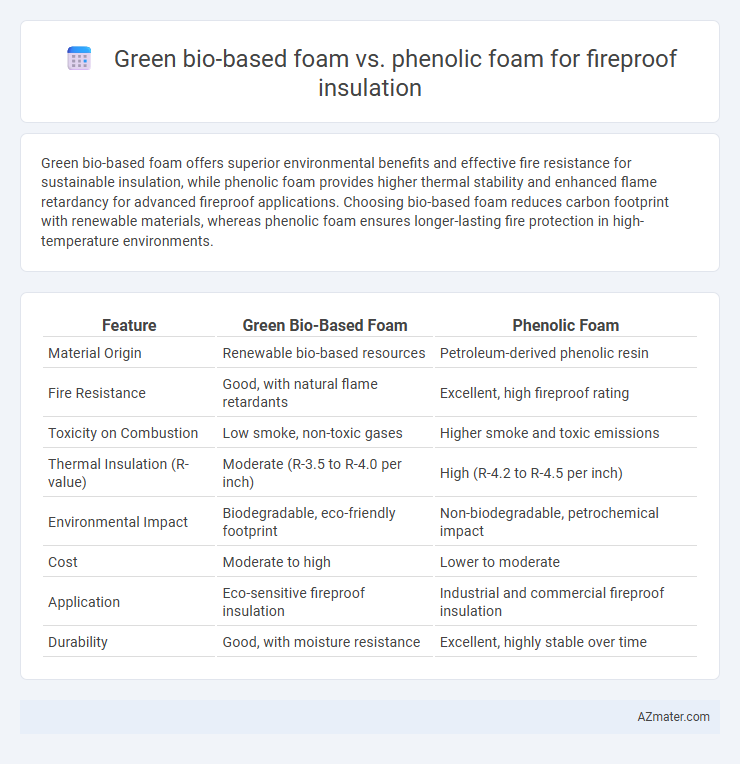Green bio-based foam offers superior environmental benefits and effective fire resistance for sustainable insulation, while phenolic foam provides higher thermal stability and enhanced flame retardancy for advanced fireproof applications. Choosing bio-based foam reduces carbon footprint with renewable materials, whereas phenolic foam ensures longer-lasting fire protection in high-temperature environments.
Table of Comparison
| Feature | Green Bio-Based Foam | Phenolic Foam |
|---|---|---|
| Material Origin | Renewable bio-based resources | Petroleum-derived phenolic resin |
| Fire Resistance | Good, with natural flame retardants | Excellent, high fireproof rating |
| Toxicity on Combustion | Low smoke, non-toxic gases | Higher smoke and toxic emissions |
| Thermal Insulation (R-value) | Moderate (R-3.5 to R-4.0 per inch) | High (R-4.2 to R-4.5 per inch) |
| Environmental Impact | Biodegradable, eco-friendly footprint | Non-biodegradable, petrochemical impact |
| Cost | Moderate to high | Lower to moderate |
| Application | Eco-sensitive fireproof insulation | Industrial and commercial fireproof insulation |
| Durability | Good, with moisture resistance | Excellent, highly stable over time |
Introduction to Fireproof Insulation Materials
Green bio-based foam offers sustainable fireproof insulation by utilizing renewable natural fibers and plant-based resins, reducing environmental impact while delivering effective thermal resistance. Phenolic foam remains a traditional fireproof insulation material known for its low smoke emission and excellent fire retardant properties due to its thermosetting polymer structure. Both materials are integral in fireproof insulation but differ significantly in composition, environmental footprint, and fire behavior performance.
What is Green Bio-Based Foam?
Green bio-based foam is an eco-friendly insulation material derived from renewable natural resources such as plant oils, sugars, and starches, offering sustainable fireproofing solutions. Unlike traditional phenolic foam, which is petroleum-based, green bio-based foam provides comparable fire resistance with lower environmental impact and reduced toxic emissions during combustion. Its biodegradable and non-toxic composition makes it a preferable choice for sustainable construction and green building certifications.
Overview of Phenolic Foam Properties
Phenolic foam is renowned for its exceptional fire resistance, exhibiting low smoke emission and excellent thermal stability at temperatures exceeding 200degC. Its closed-cell structure provides superior insulation performance with a low thermal conductivity of approximately 0.018 W/m*K. This foam material also offers dimensional stability and chemical resistance, making it a preferred choice for fireproof insulation in commercial and industrial applications.
Thermal Performance: Comparing Insulation Values
Green bio-based foam offers competitive thermal insulation values with R-values typically ranging from 3.5 to 4.0 per inch, providing effective fireproof insulation while minimizing environmental impact. Phenolic foam exhibits higher thermal resistance, often achieving R-values between 3.7 and 4.6 per inch, leveraging its closed-cell structure for superior insulating properties and enhanced fire retardancy. Evaluating thermal performance for fireproof insulation applications, phenolic foam generally outperforms green bio-based foam in insulation value but green bio-based foam excels in sustainability and lower embodied energy.
Fire Resistance: Safety Ratings and Standards
Green bio-based foams demonstrate superior fire resistance compared to phenolic foams by achieving higher safety ratings under ASTM E84 and EN 13501-1 standards, often exhibiting lower smoke development and flame spread indices. Phenolic foams, though inherently fire-retardant due to their chemical structure, can emit toxic fumes and require additional fire-retardant additives to meet stringent fire safety regulations. The enhanced thermal stability and non-toxic combustion properties of green bio-based foams make them increasingly preferred for eco-friendly, high-performance fireproof insulation in building applications.
Environmental Impact and Sustainability
Green bio-based foam, derived from renewable resources such as plant oils or agricultural waste, significantly reduces carbon footprint and environmental toxicity compared to phenolic foam, which is petroleum-based and involves hazardous chemical production. The biodegradability and lower volatile organic compound (VOC) emissions of bio-based foams enhance indoor air quality and promote sustainable building practices. Phenolic foam, while effective in fire resistance, struggles with recyclability and contributes to long-term environmental pollution due to its synthetic chemical composition.
Durability and Life Cycle of Each Foam
Green bio-based foam offers enhanced durability with natural resistance to degradation and a life cycle that emphasizes sustainability through biodegradability and lower environmental impact. Phenolic foam provides superior fire resistance and stable long-term performance, maintaining structural integrity under high temperatures but tends to have a more carbon-intensive production process affecting its overall environmental footprint. Both foams deliver effective fireproof insulation; however, green bio-based foam prioritizes eco-friendly longevity, while phenolic foam excels in high-performance fire durability and lifespan.
Installation Process and Practical Considerations
Green bio-based foam offers easier installation due to its lightweight, flexible nature and compatibility with sprayer or foam-in-place application methods, reducing labor costs and installation time compared to traditional phenolic foam. Phenolic foam requires more precise handling because of its brittle texture and susceptibility to breakage, demanding skilled labor and careful on-site cutting and fitting. Practical considerations for bio-based foam include its eco-friendly composition and lower toxicity during installation, while phenolic foam boasts higher fire resistance but poses potential health risks if not installed with proper personal protective equipment.
Cost Comparison: Bio-Based vs. Phenolic Foam
Green bio-based foam typically offers a cost advantage over phenolic foam due to the use of renewable raw materials and lower manufacturing energy requirements. Phenolic foam, while more expensive, delivers superior fire resistance and thermal stability, justifying higher upfront costs in critical fireproof insulation applications. Cost comparison ultimately depends on project scale, fire safety standards, and long-term performance expectations.
Future Trends in Fireproof Insulation Technology
Green bio-based foam is gaining traction as a sustainable alternative to traditional phenolic foam in fireproof insulation due to its renewable raw materials and lower environmental footprint. Emerging trends emphasize the development of bio-based foams with enhanced thermal stability and flame retardant properties, leveraging advancements in natural polymer composites and eco-friendly additives. Future fireproof insulation technologies are expected to integrate smart, bio-derived materials that meet stringent fire safety standards while supporting circular economy principles.

Infographic: Green bio-based foam vs Phenolic foam for Fireproof insulation
 azmater.com
azmater.com